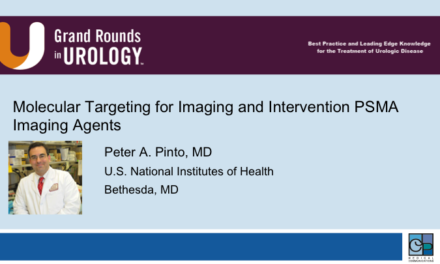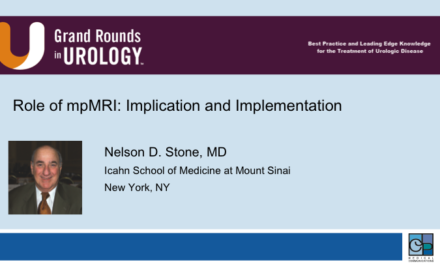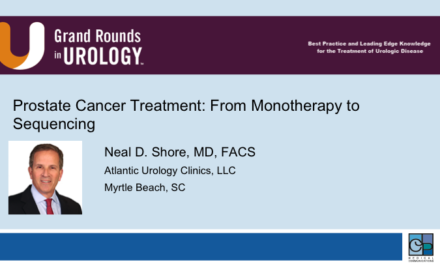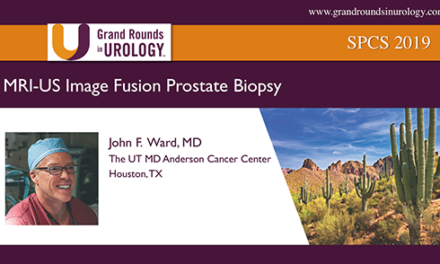Dr. Daniel P. Petrylak spoke at the 24th International Prostate Cancer Update on Saturday, February 22, 2014 on “The Latest in Earlier Stage Clinical Trials for Prostate Cancer.” In his presentation, Dr. Petrylak discusses early stage clinical trials use of agents neoadjuvantly, which target androgen receptor and the immune axis.
Presentation:
Keywords: abiraterone, androgen deprivation therapy, ARM, LHRH, PSA, sipuleucel-t, prostate cancer.
How to cite: Petrylak, Daniel P. “The Latest in Earlier Stage Clinical Trials for Prostate Cancer.” Grand Rounds in Urology. January 22, 2015. Accessed Jan 2025. https://dev.grandroundsinurology.com/prostate-cancer-daniel-p-petrylak-early-stage-clinical-trials/.
Transcript
The Latest in Earlier Stage Clinical Trials for Prostate Cancer
So I’d like to quote the great sage Yogi Berra or at least change his quote around a little bit saying thanks to all of you for making this talk necessary. This is a talk, basically, on moving some of the drugs for castration-resistant prostate cancer up earlier and I am going to talk about some trials that are being performed, as well as some important trial results that are now out there.
So this is the landscape. You can look at castration-resistant prostate cancer as a pyramid. As we see here, we move from a second line treatment such as Jevtana and Zytiga, Xtandi, Zofigo, approved in the post-Taxotere setting and as you start moving down the pyramid there are fewer and fewer treatments that are available and we start getting down to surgery and radiation therapy, as well as androgen deprivation therapy. We see that we really have LHRH agonists and antagonists approved and the question is is can moving some of these new agents that we are talking about here today improve our overall outcome?
And again, moving these forward we are seeing studies with androgen deprivation therapy and Provenge, surgery combined with abiraterone, looking at moving chemotherapy up in the hormone-sensitive statement. I think that these are important concepts to move forward.
So what about high-risk prostate cancer? We have seen this definition numerous times throughout this meeting. This is high risk for failure after surgery or radiation therapy. This includes bulky cancers, T3, T4 disease, PSAs of greater than 20 and Gleason scores of 8 to 10. Seventy-one percent of participants in a trial that I am going to describe by Dr. Phil Kantoff and Dr. Mary-Ellen Taplin and I’d like to thank them for providing slides for this, had Gleason scores of greater than 8 and 18% of patients had lymph nodes involved at prostatectomy and this is some of our previous data looking at the impact of PSA recurrence and androgen deprivation therapy after surgery and as we see looking at this neoadjuvantly, as well as adjuvantly, there was PSA relapse rates range anywhere between 11 and 40% overall and this is with as much as 4 years, 5 years of followup.
So the question, of course, is looking at abiraterone inhibiting biosynthetic pathways, either through the 17-lyase enzyme, and what the group at Dana Farber has done is looked at high risk, newly diagnosed prostate cancer, treated them with either 12 weeks of LHRH therapy or abiraterone plus LHRH therapy and these patients went on to subsequently undergo a radical prostatectomy and the endpoints of this particular evaluation were pathologic response, prostate androgen levels in the serum, as well as androgen receptor targeting.
Fifty-eight patients were accrued in this trial between 2009 and 2011 and it was a 4-institution study between M.D. Anderson, the Farber, University of Washington and Beth Israel. The last prostatectomy was performed in 2012.
These are the patient characteristics. As you can see from this, these are high-risk prostate cancer patients. Their Gleason scores ranged between 8 and 10, the median PSA was 12.1 on the LHRH arm versus 6.4 on the abiraterone arm and the PSA velocity was actually somewhat lower in the abiraterone arm, as well. Eight patients were T3 in the LHRH arm and six in the abiraterone arm.
So looking at PSA results, as one would expect, there is a more rapid decline in PSA in those patients who received abiraterone, a higher percentage of patients who received a longer duration of abiraterone had a 90% or had a less than 0.2 PSA level and 93% of those patients with the 24 weeks had a less than 0.2 PSA level.
Start looking at pathology there is an interesting trend that develops with the longer dosage of abiraterone. The pathological complete response rate was 10%. The group also had what I would call as a newer pathological endpoint, which is a near complete response, which was the tumor was less than 5 millimeters in size and that was 11% versus 24% in the 24-week versus the, excuse me, the 12-week versus the 24-week abiraterone arm. About 11% of patients in the 12-week arm had nodes, 28% in the 24-week arm and the positive margin rate was 19 and 17%, respectively.
As one would expect, looking at levels of androgens they all declined in a fashion that you would have expected. Abiraterone plus LHRH versus LHRH alone in the 12-week and 24-week period are much, much lower and, again, this reflects the same thing that we systemically in patients treated with abiraterone acetate.
Pregnenolone, progesterone, all of these increased, again, from what we have seen in the steroid pathway, as well as, androstenediol, which is also decreased, along with the overall testosterone levels.
So we look at safety the major side effects that are seen are liver function abnormalities, 13% of patients, hypokalemia 7%, no cardiac disorders were also noted in these particular patients.
So what they concluded from this trial is that six months of neoadjuvant therapy with abiraterone and then followed by radical prostatectomy was feasible. Tissue androgens were also lowered in this particular study and 34% of patients who are on the 6 months of abiraterone and LHRH had a pathological or a complete response or a near complete response and, of course, the long-term effects of these pathological complete responses need to be evaluated.
So there is a trend towards an improved pathological outcome. There appears to be low systemic and surgical toxicity. Prednisone is administered and this actually also in tissue affords us the ability to study hormone resistance. There is a larger randomized trial that is now being proposed and actually underway so this is what the plans from the Farber group are with this particular treatment.
Moving sipuleucel-T therapy up and Neal Shore has already gone over this this morning, but looking at a neoadjuvant approach to radical prostatectomy with immune therapy this was also in high-risk patients. Radical prostatectomy was recommended as initial treatment, 40 patients were randomized to receive, first receive sipuleucel-T, then receive booster activity after the prostatectomy and then were followed. I think what is important to note on this particular trial is that you can see immune markers increased at the tumor vascular interface and these, particularly important are CD3 and CD4 cells. Also, you are seeing T suppressor cells develop in that area and that actually is important to the overall equilibrium of immune therapy in patients with prostate cancer. It may be one of the reasons why we don’t see as many objective responses as we would like to.
But if we look at patients who are treated with sipuleucel-T prior to prostatectomy we see that there is an increase in the CD4, as well as the CD8 cells, post-treatment. We don’t see similar T cell infiltration in untreated patients. Same thing with B cells, there is an increase in B cells. This is paralleling what we see in patients’ serum with metastatic disease and then looking at staining of lymphocytes, both CD20 and CD3 staining, CD20 cells are the antibody producers and CD3 cells are the T helper cells. These are both present at this tumor interface. So this is, again, a treatment we may want to consider but the followup in these particular patients is quite long and it may not be practical to overall look at long-term trials.
So again, with the thought of moving immune therapy up there is an abstract that was presented at this year’s ASCO meeting they think is of relevance to sequencing immune therapy, as well as hormonal therapy and this is by Dr. Antonarakis from Johns Hopkins.
What he did was he looked at patients who were biochemically recurrent after prostatectomy or radiation therapy and he sequenced sipuleucel-T therapy along with androgen deprivation therapy. So these are patients who had biochemically recurrent prostate cancer, non-castrate testosterone levels, PSA doubling times of less than 12 months so these are rapid progressors. They could not have radiographic evidence of disease and what he did was he gave sipuleucel-T first in arm one. This was followed by androgen deprivation therapy post the sipuleucel-T.
The other group had androgen deprivation therapy initially and they were given sipuleucel-T while they were receiving androgen deprivation therapy and compared immune parameters.
So what was interesting was the immune activation was similar in both the delayed as well as the immediate arms. If you look at total nucleated cell counts, androgen-presenting cell counts, CD54 up regulation, all of these are the same. What he started to see a difference in is the humoral response or the antibody response by ELISA assay for PA2024, which is the fusion protein, or prostatic acid phosphatase and these seem to be different in those patients who have the androgen deprivation therapy first, then the sipuleucel-T afterwards. And there was also an increase in cytokines, particular interferon gamma, IL5 and IL13 in those patients who received the hormone therapy first and then the sipuleucel-T.
We know that thymic atrophy can be induced by giving androgen blockade and this may be a form of taking care of the T suppressor cells and this may be why we are seeing this effect. Also, memory T cell counts were increased for both PA2024 and prostatic acid phosphatase in the sequential arm where the hormone therapy was given first, afterwards sipuleucel-T was administered.
So, again, that has got important implications and this is something that we are going to have to consider in our trial designs. Another unmet medical need is non-metastatic castrate-resistant prostate cancer. We know a little bit about the biology of this disease to help us design better trials. We know that if you start looking at the time to progression and the overall survival there are two published studies looking at different agents. One was atrasentan that came out in 2008 and the other was zoledronic acid and the time to progression is probably about 2 years overall from the atrasentan study and about 4 years from the same study for the overall survival. And you can actually begin to plot out, as least from the Zometa trial, what the overall survival was based upon PSA doubling times, as well as baseline PSAs. As one would expect, the baselines PSAs, those of more than 24, and the doubling times of less than 6 months those are the poorer prognostic groups and about 50% of these patients will progress at 2 years.
Unfortunately, when the trials were designed we did not take into account these PSA doubling time issues and that may be one of the reasons for the failures so looking at the atrasentan versus placebo in non-metastatic patients we see there is no difference in time to progression, median survival is about four years. If you start looking at the development of metastatic disease, again, when you are looking at the atrasentan 46% of these subjects developed bone metastases by 2 years, 20% have died so this is a lethal phenotype that we need to identify.
There are two trials that are about to read out or are accruing patients that I think are of great important. Dave has presented data with the IMAAGEN trial looking at abiraterone in this same group of patients, rapid PSA doubling time, and hopefully this will be reported out at ASCO this year.
There is a randomized trial that is now underway. It is the PROSPER study. It is a trial that is looking at enzalutamide in the same space, 160 milligrams daily; patients are randomized on a 2:1 basis. They cannot have received prior lyase inhibition, nor can they have received ketoconazole and the primary endpoint is metastases-free survival.
A very similar trial is being performed with the anti-androgen ARN101 and that is going to be a registration trial in the exact same disease state.
Moving some of these lyase inhibitors up earlier is now the subject of investigation in the Southwest Oncology Group. TAK-700 is a very similar lyase inhibitor to abiraterone. It does not have the same effect on cortisol, thus, you can administer this without concomitant and corticosteroids and one of the trials that was performed in the chemo-naïve castrate-resistant prostate cancer patients who were non-metastatic demonstrated significant activity and this drug could be safely administered at low doses without prednisone or 600 milligrams with prednisone and their objective response is seen later on in phase II and, as we know, this drug was recently a phase III trial looking at the post-chemotherapy setting and was presented at ASCO GU, which showed no survival benefit, predominantly due to the fact that patients in the United States received subsequent therapies, which diluted out any potential survival benefit this drug may have had.
The thought is moving this drug up earlier in the schema of metastatic prostate cancer may improve overall survival and this is a trial from SWOG looking at LHRH therapy combined with TAK-700 compared to LHRH plus bicalutamide. There was a third arm that we wanted to put in, which was a triplet combination of LHRH, TAK-700 plus bicalutamide but there is no phase I data that we could go forth with but the primary endpoints are overall survival, the secondary endpoints are those patients who achieve a PSA of less than 0.2 versus greater than 4.0 and that has got important prognostic import for castration-resistant, de novo castration-resistant disease and those patients who don’t go to less than 4.0 overall do poorly.
This trial is accruing, actually, fairly quickly in the Southwest Oncology Group. They are getting about 30 patients on per month so I hope that we will have an answer within a reasonable period of time.
So I think the most unexpected curveball that came in the last couple of months was a press release from the NCI talking about ECOG3805. This is a multicenter, randomized, phase III trial that opened about ten years ago, I believe, which took patients with hormone-sensitive, metastatic prostate cancer, 790 patients. They received androgen deprivation therapy and will randomize to receive six cycles of docetaxel chemotherapy versus observation or nothing else. And the primary endpoint of the study was overall survival and lo and behold there is a survival benefit. So this is, again, from the press release. We are expecting to see a full presentation at ASCO this year. Sixty-nine percent of patients were alive at three years in the chemotherapy plus androgen deprivation therapy arm versus 52.5% in the androgen deprivation therapy arm alone. That is all comers that includes high-risk disease. If you just look at the extensive metastatic disease patients the difference is somewhat more striking, 43.9% for androgen deprivation therapy alone versus 63.4% so the question is is the standard of care going to now change? And then, of course, how that is going to affect the SWOG trial?
My bet is that it will and I think that pending the presentation of Dr. Sweeney’s data at ASCO this year that we are going to have to reconsider giving chemotherapy up front to these patients with metastatic disease.
So conclusions, early use of agents neoadjuvantly can confirm mechanisms of action of agents, which target androgen receptor, as well as the immune axis. Early chemotherapy may provide a survival benefit for patients with newly diagnosed hormone-sensitive prostate cancer.
References
Fair WR, Cookson MS, Stroumbakis N, et al. The indications, rationale, and results of neoadjuvant androgen deprivation in the treatment of prostatic cancer: Memorial Sloan-Kettering Cancer Center results. Urology. 1997 Mar;49(3A Suppl):46-55. http://www.ncbi.nlm.nih.gov/pubmed/9123736
Klotz LH, Goldenberg SL, Jewett M, et al. CUOG randomized trial of neoadjuvant androgen ablation before radical prostatectomy: 36-month post-treatment PSA results. Canadian Urologic Oncology Group. Urology. 1999 Apr;53(4):757-63. http://www.ncbi.nlm.nih.gov/pubmed/10197852
Meyer F, Moore L, Bairati I, et al. Neoadjuvant hormonal therapy before radical prostatectomy and risk of prostate specific antigen failure. J Urol. 1999 Dec;162(6):2024-8. http://www.ncbi.nlm.nih.gov/pubmed/10569561
Nelson JB, Love W, Chin JL, et al. Phase 3, randomized, controlled trial of atrasentan in patients with nonmetastatic, hormone-refractory prostate cancer. Cancer. 2008 Nov 1;113(9):2478-87. http://www.ncbi.nlm.nih.gov/pubmed/18785254
Schulman CC, Debruyne FM, Forster G, et al. 4-Year follow-up results of a European prospective randomized study on neoadjuvant hormonal therapy prior to radical prostatectomy in T2-3N0M0 prostate cancer. European Study Group on Neoadjuvant Treatment of Prostate Cancer. Eur Urol. 2000 Dec;38(6):706-13. http://www.ncbi.nlm.nih.gov/pubmed/11111188
Soloway MS, Pareek K, Sharifi R, et al. Neoadjuvant androgen ablation before radical prostatectomy in cT2bNxMo prostate cancer: 5-year results. J Urol. 2002 Jan;167(1):112-6. http://www.ncbi.nlm.nih.gov/pubmed/11743286
ABOUT THE AUTHOR
Daniel P. Petrylak, MD, is currently Director of Genitourinary Oncology, Professor of Medicine and Urology, Co-Leader of Cancer Signaling Networks, and Co-Director of the Signal Transduction Program at Yale University Cancer Center in New Haven, Connecticut. He is a recognized international leader in the urology field. He earned his MD at Case Western Reserve University School of Medicine in Cleveland Ohio. He then went on to complete his Internal Medicine Residency at Albert Einstein College of Medicine/Jacobi Medical Center in the Bronx, and his fellowship at Memorial Sloan Kettering Cancer Center in New York.
Dr. Petrylak has served as principal investigator (PI) or co-PI on several SWOG clinical trials for genitourinary cancers. Most notably, he served as the PI for a randomized trial that led to the FDA approval of docetaxel in hormone refractory prostate cancer. He also helped to design and served as PI for the SPARC trial, an international registration trial evaluating satraplatin as a second-line therapy for hormone refractory prostate cancer.
Dr. Petrylak served on the program committees for the annual meetings of the American Urological Association from 2003-2011, and for the American Society of Clinical Oncology from 1995-1997 and 2001-2003. He also has served as a committee member for the Devices and Immunologicals section of the FDA. He has published extensively in the New England Journal of Medicine, Journal of Clinical Oncology, Journal of the National Cancer Institute, Cancer Research, and Clinical Cancer Research.





